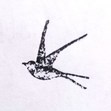Hûw Steer's Blog, page 19
September 25, 2022
Riftwar Re-Read #10 – Rage of a Demon King
Alright, people. It’s time for the actual Serpentwar.
(Just as an aside, I’m currently 4 books ahead of this in the series and taking a pause so I can catch up on reviews before I plough into the next trilogy. But the Conclave of Shadows trilogy will probably just be one big review so not too long before I can press on.)
The board has been thoroughly set. Erik von Darkmoor and his fellow fantasy commandos have gathered all the intelligence they can. Jimmy the Hand, now Duke of Krondor, has been planning the defence of the Kingdom down to the last sword. Roo Avery has (reluctantly) been preparing to fund said defence effort. And all the while, Pug, Miranda, Nakor and the rest of the merry band of immortal magicians have been figuring out just what’s behind the upcoming invasion of the Kingdom from the distant land of Novindus.
Given the title of the book, you may be able to figure that last bit out for yourself.
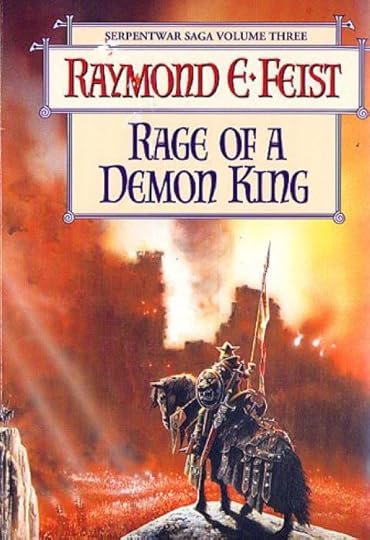 Our mysterious warrior has not only gained a shirt, he also appears to have actually stumbled across the plot! The besieged city in the background is, presumably, the besieged Krondor. Huzzah!
Our mysterious warrior has not only gained a shirt, he also appears to have actually stumbled across the plot! The besieged city in the background is, presumably, the besieged Krondor. Huzzah!I’ve also discovered that this cover, and indeed almost all of the Riftwar covers I’ve featured so far, were made by Geoff Taylor, who also painted loads of Warhammer artwork. Nice one, Geoff.
Rage of a Demon King is the part of the Serpentwar that actually covers the Serpentwar itself. There’s been a hell of a lot of setup, but I would definitely say that Rage lives up to the hype, even though by necessity it’s got a lot of moving parts. There are 4 primary POVs – Pug, Erik, Roo and good old Jimmy – as well as a host of other, shorter POVs from various characters both old and new.
With those 4 POVs come 4 main plotlines. Erik is actually fighting the war, Roo is running from it, Jimmy is coordinating it, and Pug is trying to end it at the source before the world gets blown up. It’s a tricky proposition but Feist manages to balance everything very nicely – and because the war is being examined from so many different angles, it becomes an extremely well-realised and described thing. All the death and destruction has meaning, and it comes across well.
The first bit of the book is the last preparation time before the invasion. We get a last glimpse at ‘normal’ life in the Kingdom for our protagonists, which is a very effective way to contrast everything going to hell in the second act. Especially as, while most of the ordinary folk of Midkemia are just getting on with their lives, our protagonists are well aware that the clock is ticking.
We also get reintroduced to some of the other characters who’ve made all this happen from the start – as in, in the earlier Riftwar books. Prince Nicholas, star of The King’s Buccaneer, is now Lord Admiral of the Kingdom fleet, ready to take on the invaders at sea. (In a nice nod to changing times, the Royal Navy is now distinctly Napoleonic in flavour despite everything still being swords and crossbows.) William, son of Pug and one of the protagonists of the infamous Krondor trilogy, is now Knight-Marshal of Krondor and basically in charge of the whole ground defence. A whole raft of other minor characters show up too… and not a lot of them survive.
Because this is a war, and if the much darker tone of the first two books didn’t clue you into what was going to happen when the Serpentwar actually kicked off, then the abrupt death of some characters who’ve been happily living their lives for the last 6 books will certainly do it.
The action is great. Erik von Darkmoor has come a long way from burly teenage murderer. Now he’s effectively one of the top generals in the whole Kingdom, but he’s still leading from the front and getting stuck in. His POV shows us brutal fighting from Krondor back up into the mountains, showcasing a brilliant siege of the city and all the subsequent retreats and last stands. He’s a grizzled veteran – as, by now, are we, having followed all his adventures to this point. He stands in marked contrast to most of the young soldiers around him who don’t even know where Novindus is.
A great counterpoint to Erik’s narrative is given by our wannabe Merchant Prince, Roo Avery. He’s running away from the fighting, but not entirely successfully, and through him we get to see what the poor civilians of Midkemia are subjected to during the invasion. It’s not pleasant, and it provides some fantastically tense scenes – especially when all of Roo’s bad decisions from Merchant Prince inevitably come back to bite him.
Meanwhile, Duke Jimmy and a few other characters are looking at the war from the top down, and despairing as their carefully laid plans are dashed one by one in the face of overwhelming force. Despite two books’ worth of preparation, the armies of the Emerald Queen are still just too strong. Which means falling back on a truly last-resort plan on Jimmy’s part… the nature of which I am loath to reveal, so if you don’t want too many spoilers, look away.
He blows up Krondor. While still inside it. One of my favourite characters, giving his life for the city that made him and the city that he made his own. It’s one hell of a scene, because Krondor has, essentially, been a major character in its own right. The Riftwar may have begun out in Crydee, and until now all its battles have been fought elsewhere. But Krondor was where Arutha ruled. It was where Jimmy the Hand grew up. It was the beating heart of the Kingdom and the plot; almost everyone’s home base, whether in the Prince’s palace or the seedy underground.
Jimmy the Hand is gone, and Krondor with him. And Feist writes it beautifully.
Less beautiful, but still good, is the last strand of the plot, and the one with the grandest, if not the best-realised, stakes. Pug and all the other magicians are standing by to stop the Emerald Queen herself from reaching the Lifestone underneath Sethanon and blowing up the world. Because the Emerald Queen is actually the titular Demon King. (Surprise!) This involves various attempts to fight her with magic – which, for once, fail dramatically, almost killing Pug outright. It’s refreshing to see Pug, who’s been creeping slowly towards godlike power levels, get brutally knocked down a couple of pegs; it reinforces the stakes and makes him a much better character in the aftermath. Even the unstoppable Tomas is very nearly proved stoppable.
(The presence of various demons is also important for setting up the next arcs of the whole series, which start delving into other planes of reality and all sorts of stuff like that – but right now that’s not important.)
The bit I don’t like about this plotline is that it ties up Calis. Throughout the last two books, Calis has been acting as a badass commando captain, leading elite units and generally masterminding the defence of the realm. It’s his plans that Erik is following to defend Krondor, his training that everyone is relying on. But when the actual fighting comes… Calis isn’t there. Because he’s ‘borrowed’ by Pug and company to defend the Lifestone (as, due to Magic Reasons, he’s the only one who can neutralise its power, being part elf, part human and part Dragon Lord). Now, if Calis was actually angry about this, or resisted being co-opted, I wouldn’t mind. Because that would make sense: he’s spent half his life preparing to fight the Emerald Queen, and being taken away from the fighting when he’s most needed would make him absolutely furious. That would be very in keeping with his character. It would have made for a dramatic moment, too, if Pug had to literally pull Calis away from the war to force him to confront his destiny.
But instead, he just… goes along with it. All his badassness just sort of evaporates, and Calis abandons the war he’s trained for for decades without a second thought. And it makes the whole mystical plot feel a bit flat as a result. It saddened me, because it’s a poor use of a really good character. Definitely one of Feist’s low points.
As a last aside, I’m going to have to talk briefly about the Krondor trilogy. Because as I mentioned in my last review, there was an unexpected appearance from a random side character: Lysle Rigger, whose only distinguishing feature was that he looked just like Jimmy the Hand. In the Krondor trilogy, he is ultimately a pointless aside that adds nothing to the narrative at all. But he’s back, and he is very relevant. Because he’s now the head of the Guild of Thieves, and suddenly a pointless aside has become a nice mirror to Jimmy the Hand – now Duke James – and an insight into what might have been, had Jimmy not gotten involved with the main plot back in Magician.
There’s also a great little moment where one of my least favourite things about Krondor is finally paid off. As I mentioned back in my review, several chapters in Betrayal end on a character picking up a magic item and going ‘oh this is cool, I’m sure it’ll be useful later’… and then never using them again. Well, in the middle of Rage of a Demon King, one of those very magic items is finally, finally ‘useful later’. It was a small moment, but I loved it.
In summary (after what’s turned into my longest review yet, I think), Rage of a Demon King delivers on almost all fronts. The Serpentwar has been long in the coming, and though the actual fighting is fairly brief, it’s worth the hype. The Kingdom is left mostly triumphant, but in ruins. Many protagonists gave their lives for it. Plot threads from some of the weakest books in the Riftwar are rendered useful. Despite a few flaws, Feist delivers what must have been a very complex book to write and he does it well.
But while the Serpentwar is over, the Serpentwar is not. There’s one book left. Because the Kingdom is in ruins, and someone has to pick up the pieces.
Jimmy the Hand is dead. Long live the Jim. And the Dash.
(You’ll get it next time, honest.)
September 18, 2022
Environments
Of the ‘big three’ elements of any story – character, plot and setting – I’ve always thought character to be the most important. A really good character can be dropped in any setting and sort of make themselves a plot just by interacting with the world. But that, of course, requires there to be an interesting world for them to interact with. (And for the plot they create to be well-realised and written, but I want to talk about setting and environment today.)
Now in fantasy and sci-fi – in which I write – the temptation is of course to go crazy, and create environments and settings that are very different to our own. Like, I don’t know, making the seas hot, or building megacities in craters on the Moon. Or (in unfinished and unreleased things) having all life on a world exist in one temperate valley, on asteroids with artificial oxygen, or a hundred other things. But while creating these grandiose environments is a lot of fun, which is why I keep doing it, lately I’ve been trying to remind myself that while they might be fantastical, they also have to be believable. Which means steering away from the epic descriptions, and making sure I’m including the little things that make unbelievable worlds seem real.
I am always carrying at least one notebook for random ideas and the like. This summer I started a fresh one, however, specifically for environmental notes. Drawings of interesting – or ordinary – buildings, stretches of waterfront, fields. Notes on what the air feels like, what the ambient sounds are. I’m only just beginning the notes, but I went to Spain a couple of times this summer and recorded quite a few cool things there, and as I write this I’m at my parents’ home in Herefordshire. Spending so much time in the city I tend to forget just how different and pleasant the countryside can be. The lack of noise is probably the biggest and nicest thing. There’s no background hum of traffic, no horns, no sirens. There’s just birdsong and the church bells.
These are the little details that are so important to creating a good, believable setting when writing. They’re the little details I’m trying to use more often. It’s all well and good writing about a fantasy city’s soaring buildings and grand boulevards, but what does it sound like? What does it smell like? When your characters quest forth into the countryside, they’re going to notice the quiet, yes, but also the cold, as they leave the insulating blanket of all those buildings. They’ll be able to see the stars at night too. When I’m writing about a port, I need to know what harbours actually look like, what kind of businesses and shops make their homes along the waterfront. I need to know what waterfronts actually look like too. (The wharf I describe in ‘The Vigil of Talos’ is actually based on the beachfront in the very Spanish town I stayed in the other week.) I need to write about the smell of salt and seafood as well as the sight of the grand battleships hoving into port.
Try it for yourself. Pull your focus back and really look at your surroundings. Find the small things. Remember them. Describe them. Add them to your writing. They are the seasoning that will make a bland dish delicious.
September 11, 2022
Riftwar Re-Read #9 – Rise of a Merchant Prince
One expects certain things of a classic epic fantasy series. Swords, sorcery, gods and demons, huge battles and heroic deeds. So far, the Riftwar has delivered on all these fronts. The first book of the Serpentwar took a slightly grittier tone, but there was still plenty of adventure, derring and also do. So you’d expect the second Serpentwar book to follow suit.
You certainly wouldn’t expect it to be a business thriller about merchant trading, primarily based in a fantasy stock exchange and focusing on the Kingdom of the Isles’ economy. You certainly wouldn’t expect that to actually work really well.
(Ok, it is called Rise of a Merchant Prince, so maybe you’d realise pretty quickly.)
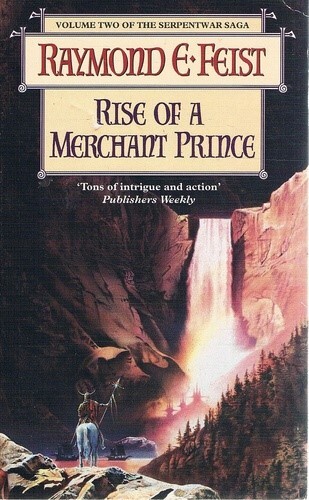 Random Shirtless Guy has gained a shirt/robe, a different horse, and also a pointy stick. No idea where this is meant to be, though.
Random Shirtless Guy has gained a shirt/robe, a different horse, and also a pointy stick. No idea where this is meant to be, though. Shadow of a Dark Queen set up the main conflict of the Serpentwar. The… Serpentwar. The armies of Novindus, led by the Pantathian Serpent Priests, are going to invade the Kingdom and try to blow up the world with the Lifestone. But thanks to the secret commando mission in book 1, they’ve been delayed, which buys the Kingdom some time to figure out how to defend against them. Erik von Darkmoor, our original protagonist, is now a veteran, so he gets to train more soldiers for another desperate intelligence mission across the sea. But he is not the protagonist of this book. That would be the titular wannabe merchant prince: his cunning rodent of a friend, Rupert ‘Roo’ Avery.
Roo isn’t staying with the army. Roo wants to get rich. And so, leveraging some connections from book 1 and using his battle-honed instincts, he does. The book’s main plot is Roo’s rise from wagon-driver to fabulously wealthy businessman, starting out by trading luxuries and then leveraging the global grain market.
Yes, I did say global market. In a medieval fantasy book. But there’s been a time-skip since Arutha’s day, and quite a lot has changed – and this economic plot is actually a really good way to illustrate it. This is the longest look at civilian life in the Kingdom we’ve really had in the series. We get an insight not into the nobility but the middle class – independently wealthy merchants and traders, all just living their lives. There’s a touch of ‘high society’ in Barrett’s Coffee House, which serves as a primitive stock exchange, and gives us insights into things like fashion, foreign goods and the like. This spell of peacetime, told from the perspective of a relatively ordinary person, is a great way to show what ordinary life in Feist’s world is like.
But of course it’s not just ordinary life, because there is a war coming, and while most people don’t know about it yet, Roo does. There is an edge of panic to everything, as subtle preparations are made for the coming conflict. Roo’s not spared either. He’s a very wealthy man, who’s already been useful to the Crown… and the Crown, in the form of good old Duke James of Krondor – Jimmy the Hand – is not about to let an asset like that get away. We see glimpses of James’ plans, but nothing concrete yet. That’s all coming in book 3. Roo’s plot is really interesting, but ultimately this is all a setup for the Serpentwar proper in book 3. It’s true in Roo’s own plot too: intrigues are planned, traps are laid, and there are plenty of unsavoury characters waiting to pounce on this upstart ‘merchant prince’ and lay him low. (Not undeservedly, either. Roo, while a charming rogue, is also a philandering, scheming bastard of the first degree, and a lot of his upcoming comeuppance definitely feels like he had it coming.)
Meanwhile, Erik, Calis and various others are off to Novindus again to gather some more intelligence, which of course leads to learning that things are going to be even worse for the Kingdom than they’d thought. It’s really not much of the book, but it at least lets us know what our other protagonists are up to. Pug is also there, but he spends quite a lot of time relaxing on a desert island. Perks of being a magical demigod, I guess.
There are some very nice emotional moments too, largely tied to the deceased members of the Riftwar’s vast cast: Jimmy gets a lot more screentime, and thus some very sweet moments where he remembers – and wishes for – old Arutha. There are also a couple of characters who you’d think were dead who actually aren’t, which is pleasantly surprising if not hugely plot-relevant.
But the best callback of all is not to the main Riftwar series. It’s to a little side-character named Lysle Rigger, who appears in the middle of a meandering and seemingly pointless plot-thread in… Krondor: The Betrayal. That’s right. The Krondor trilogy is, to my enormous surprise, actually going to be relevant to the main Riftwar. And it only gets better in book 3. I’m sorry, everyone: you might have to read them after all.
It’s an unusual story, with an unusual protagonist. It’s fundamentally a setup for later books, sidelines most of the fighting, and takes place in a lull in the main action. But it’s a damn good book. Rise of a Merchant Prince really is full of surprises.
September 4, 2022
The Best Brosnan Bond Film… Sort Of
Here’s a question for you: what was Pierce Brosnan’s final appearance as James Bond?
You may think of the rather good Goldeneye, with Sean Bean as such a compelling villain. You may think of Tomorrow Never Dies, with Jonathan Pryce as such an utterly ridiculous villain. (Seriously, he’s a scenery-chewing Rupert Murdoch who starts a war so he can… publish the news stories before anyone else. That is his plan. I love that movie.) Or The World Is Not Enough, which is fine, or Die Another Day, which is a bit rubbish.
But you would be wrong. For another Brosnan Bond was made, in 2004. It was a video game, and it was amazing. It was Everything or Nothing.
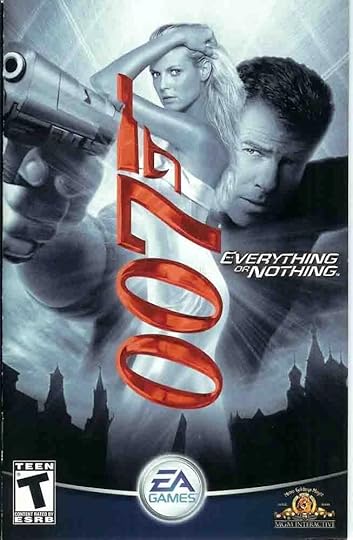
(Remember this, if nothing else, for pub quiz purposes.)
Now until very recently I hadn’t played Everything or Nothing in a very long time. I had it as a kid, for my venerable old PS2 (which still mostly works, but needs a bit of hardware surgery before I play it properly again). But I lent it to a friend and never ended up getting it back. (I do still have said friend’s copy of Drakengard, in fairness.) In more recent years I hunted in vain for a digital version, but the PSN store came up short and it was never on PC, so I mostly forgot about it. But then a few weeks ago, RTGame posted his playthrough of the game on YouTube, and all the nostalgia came back. I figured out an emulator. I found the right files. After well over a decade, I played Everything or Nothing again.
The plot is very much that of a later Brosnan Bond film – i.e. somewhat ridiculous. Some nanobots get stolen, and Bond has to track them down before villain Nikolai Diavolo (who, in a nice touch, is the mentee of Max Zorin from A View to a Kill and thus has a good motivation to hate Bond) uses them to blow up the world, or something like that. Basically it’s an excuse to send Bond around the world hunting evil scientists and blowing up increasingly exotic locations, from the Valley of the Kings to the Kremlin.
I will be clear from the start: if this was an actual Bond movie, it would not be one of the great ones. Mostly, this is because it’s a video game, and as such it needed to be much more exaggerated and ridiculous to be fun to play. Towards the end you’re running around fighting nanobots and platinum tanks, and it all gets rather silly… but that doesn’t mean it’s not a lot of fun, and honestly, it’s still probably a better ‘movie’ than some of the actual films. The gameplay itself is solid: you have your standard running around as Bond sections, featuring much shooting and punching and sneaking and gadgets. There are multiple vehicles to drive, including a couple of motorbikes, the obligatory Aston Martin (the Vanquish from Die Another Day), and a Porsche Cayenne that can turn invisible. Which leads to the oddest inclusion, which is the vehicle stealth missions, the only true stealth missions in the game. Which are conducted entirely inside a large, temporarily invisible 4×4. It works well enough.
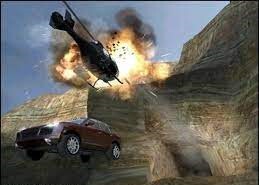 Image from cubed-3.co.uk
Image from cubed-3.co.ukBut all the way through, you’re hearing Pierce Brosnan’s quips and John Cleese’s admonitions, because this was the game’s unique selling point: for the first time, it actually had the real cast in it. Previous Bond games had made big noises about how they were allowed to use the ‘likeness’ of Pierce Brosnan – i.e. have a completely different actor and make the PS2-era graphics vaguely resemble Brosnan. But Everything or Nothing actually got Brosnan’s voice. And his face – which, while it obviously looks dated now, was pretty damn good for 2004. They also got Judi Dench as M, and John Cleese to play Q. And the bad guy was Willem Dafoe, whose Nikolai Diavolo, despite his silly name, is actually a decent villain. The various other characters are also played by recognised actors, including pop star Mya.
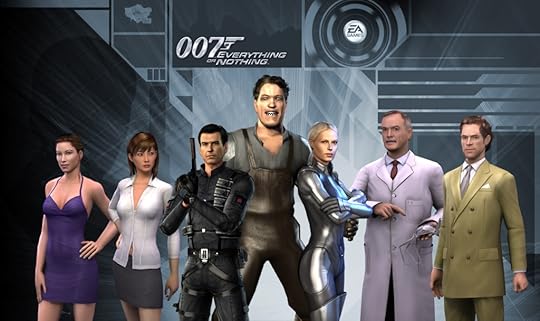 Look at those 2004 graphics. They ain’t bad.
Look at those 2004 graphics. They ain’t bad.And it’s got Richard Kiel as Jaws! Never mind how he managed to get out of space in Moonraker, Jaws is back for a bunch of boss fights because why not.
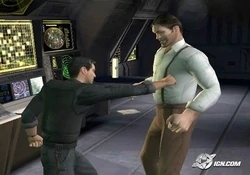 Ow. (Image from IGN)
Ow. (Image from IGN)They had the proper Bond cast, and a proper Bond plot, decent graphics and good enough gameplay. EA presented this game as a cinematic experience: lots of cutscenes, lots of big set-piece moments, lots of Bond quips and action. You get rewarded in-game for ‘Bond Moments’ (as is tradition in most Bond games) – i.e. doing cool stuff that Bond would do, like leaping out of windows, doing stunts with the car, or, in one mission, taking time out of your world-saving schedule to give a random woman a back massage.
And to kid me, it was a Bond movie. I was James Bond, doing all the James Bond things in gloriously graphiced fashion. When compared to Bond games like Nightfire (which, to be clear, I adore in similarly nostalgic fashion due to years of playing the multiplayer with my cousins) there was no contest for me.
And to adult me, replaying it now? It’s a bit janky. The graphics are good for the time but not up to much now. The plot is very silly and it’s very ham-fisted.
And I adore it. Because it’s stupid. Because I get to drive around in an invisible Porsche and punch bad guys in the face. Because despite all the flaws, Everything or Nothing is a damn fun Bond movie.
August 28, 2022
Riftwar Re-Read #8 – Shadow of a Dark Queen
Right: I’ve spent far too many reviews in this series banging on about how dark and good the Serpentwar books are. It’s time to actually tell you about them.
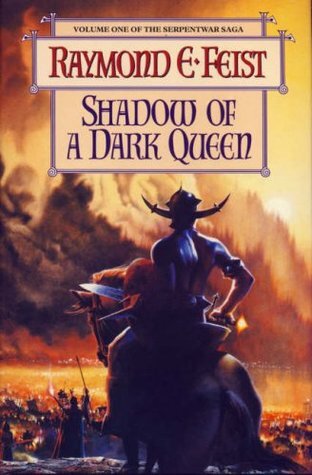 Introducing our new Cover Protagonist: Shirtless Bloke On Horse. Who is he? Where is his shirt? Only time and 3 more covers won’t tell.
Introducing our new Cover Protagonist: Shirtless Bloke On Horse. Who is he? Where is his shirt? Only time and 3 more covers won’t tell.Previously on Rift Space Nine: the Tsurani invaded, then an evil elf tried to blow up the world (but he was actually a snake), then everything was quiet for a bit, then some evil pirates tried to start a plague (but they were also actually snakes). Prince Arutha is a classic fantasy hero. Jimmy the Hand has gone from thief to politician. A boy called Pug is the most powerful wizard in the world, and his best mate Tomas is an elven demigod.
It is now twenty years later.
20 years. It’s a hell of a time-jump. Feist does a good job of subtly improving and changing bits of Kingdom society and tech – there’s a stock exchange now, the Navy is starting to look very Napoleonic, etc. – but it’s in the characters where the time jump and its consequences really hit home. Within the first 50 pages, offscreen, Arutha, Prince of Krondor, falls, breaks his hip, and dies. The original old guard, our epic heroes of the first books, are gone. (Except for Pug, obviously.) Their loss is keenly felt throughout this series. If people like Arutha had still been around, many characters think, maybe things wouldn’t have gone quite so wrong. But they’re dead and gone. There’s no going back.
The main character who thinks this, I am delighted to report, is of course good old Jimmy the Hand – the boy-thief who is now an old man and finally, finally, the Duke of Krondor. He’s in fine scheming form for this whole series, only now his scheming is turned towards the survival of the Kingdom, and preventing a very different kind of war to those Feist has described before.
In the Riftwar trilogy, the Riftwar itself comes out of nowhere. None of the protagonists are expecting the Tsurani invasion, and they’re all thrown headlong into the fighting alongside their own personal journeys. And because we’re focusing in the main on Pug and Tomas, and the actual war plotline with Arutha and company is half-focused on Kingdom politics and stopping the war, it feels much more like a straight epic than a ‘war story’. The battles in Sethanon are more in the latter vein, as we have a more conventional ‘bad guy’ trying to invade the Kingdom, but again we’re largely thrown straight into the action.
But in the Serpentwar, our protagonists know the war is coming. They’ve known since The King’s Buccaneer that the Pantathian Serpent Priests are going to try and burn the Kingdom to the ground. And so they’ve spent the last 20 years trying – and failing – to stop the Serpentwar before it starts.
The second main difference is in the choice of main POV characters. For pretty much the whole series so far, we’ve followed one or more members of the Kingdom’s royal family – Arutha, Borric and Erland, Nicky, etc. – alongside Pug, Jimmy and co. It’s all been noble men and women on noble quests to defeat the forces of darkness. While the protagonists of the Serpentwar are still trying to defeat the forces of darkness, they’re not doing it willingly, because – at first – they’re all desperate criminals who’ve traded a hanging for a suicide mission.
The first two books of the Serpentwar – Shadow of a Dark Queen and Rise of a Merchant Prince – are the buildup to the war itself. Erik von Darkmoor and Roo Avery are a pair of teenage murderers recruited at the gallows for an elite commando unit that sails to Novindus to gather vital intelligence about the upcoming invasion. It’s led, pleasingly, by Calis, half-elf son of good old Tomas, who is now a full-on badass. The first book deals with the recruitment of Calis’ Crimson Eagles and their first mission to Novindus. And it’s brutal. Feist pulls no punches in describing how tough the training is, how cut-throat the enemy – and the good guys – are. The description of Erik and Roo going to the gallows, to the point where the nooses go around their necks and the box gets kicked, is harrowing. All the Crimson Eagles are violent murderers already, and they’re being trained to be better violent murderers with extra loyalty. Even the returning characters are rendered more dark – Jimmy is a driven, haunted man; the bright, beautiful Gamina is reading minds in a courtroom to secure guilty verdicts. Even Nakor – the comic-relief magician – gets broody.
Erik is a good protagonist: he’s big and strong but also only 15 years old. His journey from scared child to extremely capable and motivated soldier is well-realised – all the convicts, it turns out, have some hidden depths to them. It’s also nice to see Novindus through fresh eyes, as it’s got some fresh elements to it. Giant lizard-men, for one thing. The Eagles are there not to fight the enemy army of the Emerald Queen, but to infiltrate it, and so we get to see the enemy from the inside. Which means, once again, encountering the Pantathian Serpent Priests, who in this book finally go from Mysterious Evil Snake-People to Motivated, Malicious Evil Snake-People. They want, it transpires, not just to invade the Kingdom, not just to conquer, but to get to the Lifestone, the great MacGuffin from the end of Sethanon. If they do, they will be able to destroy the entire world. Again, re-learning about these cosmic threats to existence through the fresh eyes of Erik is really refreshing: we know about the Dragon Lords and the Lifestone and lots of magic stuff already, but the reactions of a proper everyman to all this magic madness really hammers home how serious it all is. The character of Calis also forms a nice bridge between said magic madness – his father being Tomas, who is a Dragon Lord – and boots-on-the-ground practicality.
Ultimately, the mission to Novindus sees most of the protagonists die horribly. The intelligence they recover is, essentially, that the Kingdom is monumentally screwed, and there’s very little they can do about it. Even the B-plot of new magician Miranda tracking down Pug for a cosmic solution brings very little hope.
This is not Magician. This is not a tale of noble knights and wizards. This is a kingdom fighting to survive, and realising that in all likelihood, it won’t.
I really admire Feist for changing tack like this, in the middle of a long and established series. All those tales of heroism and derring-do after the original trilogy set a very different tone for what people must have expected from the Riftwar books to what Feist actually gave them. But it works. All that build-up helped make the world of Midkemia that much more vibrant and fleshed-out. It made me care about it that much more… which raises the stakes very nicely when it’s all about to go so very wrong.
August 21, 2022
Second Chances – SPSFC #2
I am very pleased to announce that Ad Luna is in the running for the second Self-Published Science Fiction Competition – the SPSFC. Or the Spacefic, as we’re apparently calling it now.

The elephant-memoried among you may recall that this is not the first time I’ve made this announcement. Ad Luna was a contender in the first SPSFC… briefly. It was part of Fantasy Faction’s intake but got eliminated in the first round. Such is life – I happily followed the rest of the competition as an outsider. (Iron Truth, the ultimate winner, looks bloody good.) I also appear to have forgotten to mention that it got eliminated on this blog – can’t remember if I just forgot or quietly swept it under the rug, forgive me.
But when the second SPSFC was announced, it came with an unexpected twist: books that were eliminated in the first round were given ‘A Second Chance at Love’ – namely, an opportunity to have another go with a different team. I squeezed in an application just before the competition deadline… and made it.
So, in summary: Ad Luna’s back, this time with the fantastically-named GSV Galactic Beards. The competition’s only just begun, and the whole thing will take a year to reach a conclusion, so I doubt I’ll have any updates any time soon. In fact I hope I don’t have any updates for a while, because that would probably mean I’d been knocked out in the first round again!
But it’s very nice to be back in contention, after not having had anything eligible to enter SPFBOs 6 or 8 (Ad Luna also having been eliminated from SPFBO #7 a few years ago). (Both competitions require the books to either be standalones or the first in a series – so Nightingale’s Sword is out). All being well I will have an entry for SPFBO #9, though…
The SPFBO and SPSFC are great representations of their respective bits of the self-publishing community – everyone’s very friendly and very welcoming. I’ve made some good friends through the previous competitions and found some excellent books. Not having entered anything for a few years, I’ve been more of an observer than an active participant for a while – but now I’m back, and a void I hadn’t realised was there has been filled.
And I’m glad to get Ad Luna back in contention for something again. Because as weird and niche as it might be, I’m very proud of it. I spent a long time writing about Lucian and his mad vision of space, and being able to write a version of it myself was a big moment – especially as I got to do justice to some parts of the True History that really don’t get enough attention in Lucian’s original. I like this book. I hope other people like it too. And if I’m lucky, this competition will get some more people reading it.
I’m glad to be back in the running. And who knows? Maybe I’ll get past the first round this year…
August 14, 2022
Riftwar Re-Read #7 – The King’s Buccaneer
I’m back into the Riftwar with a vengeance of late – after a fairly long break, I’m now devouring the Serpentwar series and absolutely loving it. (Seriously: I started Shadow of a Dark Queen at the beginning of the week and I’m already well into Rage of a Demon King.) So I sat down today to write about the first two books in the series, only to realise that I’d completely forgotten to write about The King’s Buccaneer. Which actually turns out to be a good thing, because I’d forgotten how well the book serves as, essentially, Serpentwar book 0.5.
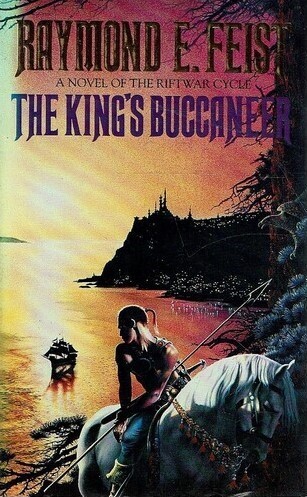 Again, in the finest tradition of old fantasy cover art, I have no idea who the bloke on the horse is meant to be. But at least this one’s got a boat in it, which is plot-relevant.
Again, in the finest tradition of old fantasy cover art, I have no idea who the bloke on the horse is meant to be. But at least this one’s got a boat in it, which is plot-relevant.In Prince of the Blood we followed the twin eldest sons of our old friend Prince Arutha. But we also see his youngest son, Nicholas, who gets his revenge on his brothers for tormenting him by starring in a much longer and – arguably – better book of his own. Borric and Erland, on the surface, aren’t very much like their father. Nicholas is very like Arutha, which may be what makes him such a good protagonist for me. He’s quiet, intense, and broody, just like his dad. He also has a crippled foot, which invests him with an inferiority complex that he gradually overcomes throughout the story (as, indeed, through magic etc. he overcomes the actual disability). Paired with the roguish Squire Harry as a more Borric-like foil, Nicky is a compelling lead.
The actual plot takes us back to Crydee, where the Riftwar all began, which is a pleasant diversion – we get to hang out with Martin Longbow the quintessential ranger for a bit and reacquaint ourselves with a few side characters who haven’t been seen since Magician. But then plot needs to happen, so Crydee is burned to the ground by pirates, who kidnap the surviving population and sail off to the other side of the world. Nicky, Harry and company take a ship and sail after them on a rescue mission. Said company includes Martin’s son Marcus – basically there to be a grumpy rival to Nicky – the redoubtable pirate turned soldier turned admiral turned pirate again Amos Trask (who is always great fun, even now he’s an old man), Ghuda Bule and Nakor from Prince of the Blood, and Calis, son of Tomas and the elf queen Agralanna. Those last two characters are extremely important. I’d forgotten just how important until I started the Serpentwar. The mad magician Nakor is fundamentally entertaining, and I knew that he’d continue to be important as the series progresses, but I’d forgotten all about Calis. In this book he’s just a useful aide to Nicky, being half-elf and therefore a bit superhuman. But the things Calis sees on this mission to the other side of the world are the catalyst for the whole Serpentwar. Watch him carefully, dear reader.
To turn to the other side of the world, this is our first sighting of the continent of Novindus, an entirely new part of Midkemia. It’s hot and deserty, full of roving bands of mercenaries, and while it’s similar in many ways to Kesh (as visited in Prince of the Blood) the nomadic aspects and the constant conflict make it a pleasingly novel setting. This is where the kidnapped villagers have been taken, and so Nicholas and his crew turn themselves into a mercenary company in order to infiltrate Novindan society, find their friends and stage a daring rescue.
It is at this point, thanks to the POVs of the two captured love interests, that we realise this isn’t just a kidnapping. It is, in fact, a plot to overthrow the entire Kingdom – by means of a virulent plague and magic doppelgangers infiltrating society, all orchestrated by the real bad guys: the Pantathians, a race of evil snake-people who want to destroy the world.
Note ‘snake-people.’ You have three guesses as to who the antagonists of the Serpentwar series are.
We’ve met the Pantathians before this point (though I haven’t mentioned them due to spoilers): they turn up in Sethanon and are alluded to in the Krondor trilogy too. But now they’re centre-stage for the first time, finally revealed as a serious threat to the world as our characters know it, and to other worlds besides. Their presence takes what is seemingly an entertaining, swashbuckling coming-of-age story and gives it a much darker undertone. The story of Prince Nicky and his friends is a cracking yarn, full of pirates and thievery and adventure. But while the Pantathians are defeated, we are left in no doubt that they will try again. It might take them a long time, but they’ll try again, and again, and again, because they will stop at nothing to achieve their goals.
And 25 years later in the Serpentwar, they do.
Yes, 25 years later. The King’s Buccaneer is simultaneously an epilogue to the first arcs of the Riftwar and a prologue to the next big cycle. Prince of the Blood and Buccaneer are ultimately stories set in the peacetime earned by the first generation of characters: Arutha, Jimmy, and all the others. It’s part of what makes them such pleasant stories in the middle of the series, and shows Feist’s forethought to good effect. The original trilogy deals with two massive wars and all the fallout thereof – Midkemia is fundamentally changed by their events. Prince and Buccaneer are, despite their thrilling plots, slow moments in the series. They’re breathing spaces. It doesn’t make them any worse as novels – in many ways it makes them better. Because they’re also opportunities to say goodbye. As you close Buccaneer, remember that you will never see most of that first generation of characters again. Aside from the magic ones – Pug and Tomas, basically – their time is done.
The first cycle of the Riftwar is over. The next is about to begin. And it’s a brutal one.
August 7, 2022
Submissions
In my new life as a More Full-Time Author Than I Was Before, I’ve not just been writing. There’s much more to do than that. Apart from my dubious and ongoing efforts at sorting out publicity, and all the editing I’ve still got to do, I’ve been hard at work submitting stuff. Behold, if you will, the mighty Submissions Widget.
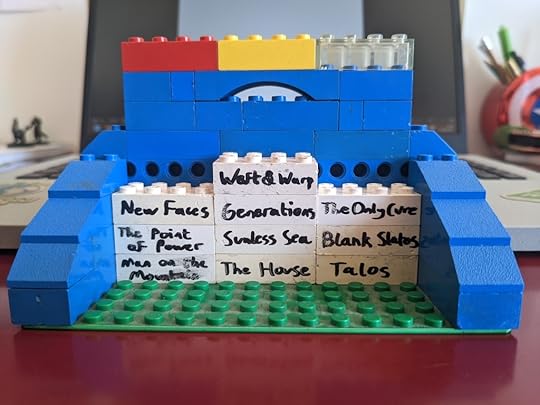 Red is available, yellow’s submitted, and clear (because I didn’t have green) is accepted.
Red is available, yellow’s submitted, and clear (because I didn’t have green) is accepted.This device is just for short stories – of which I realised I have a surprising number ready to go. Many had been languishing for some time without being sent anywhere, so my first order of business was to sort that out and get as much as I could into the wind to see what stuck. As you can see from the contents of the red column, I’ve already had some rejections. But the height of the yellow column continues to give me hope. And while I haven’t had any new acceptances (the 3 in the clear column were added for morale purposes), there’s no sense getting down about it. As I’ve remarked before, the life of an author is a life of constant rejection interspersed with shining moments of acceptance and glory. Especially with short stories.
Submissions to literary agents, however, are a whole other thing. If you’ve never done one, they are essentially job applications (or at least as much effort). You’ve got a full cover letter to write, a synopsis to beat into shape, and an extract to prepare – like with short stories, of varying format and length. It would be very convenient if at the next Grand Convocation of Editors and Agents if everyone could just sit down and agree on one manuscript format and extract length to use going forward. (But obviously different recipients have different requirements, so it’s absolutely fine – just time-consuming.)
And, I’ve discovered, they’re just as nerve-wracking as job applications. With a short story it’s somewhat easier to adopt a fire-and-forget approach (emphasis on somewhat): the cover letter is shorter and the content is too, and if the editor doesn’t like it, it could be worse – it’s only a few thousand words, after all, and I’ve got plenty more in the pipe.
But a book? That’s a different beast. That’s tens of thousands of words, waiting to be read. And it’s an extract, which means you’re constantly worrying about whether the selection you’ve prepared is a good enough representation of the book as a whole. I’ve sat for hours debating over frontloading action scenes or Flashy Stuff for submission purposes even if it throws off the flow of the actual story I want to tell. It’s like flyering at the Fringe Festival – you’ve only got so long to give a pitch before the people you’ve accosted on the street manage to escape, and even if they take your piece of shiny paper there’s no guarantee they’ll do anything with it.
So you hone your pitch, or your cover letter, or your synopsis, and of course your manuscript. You get them looking as good as you possibly can. And you send them off, and it’s still mostly up to Dame Fortune whether you’ve picked the right person and whether they’ll like it.
In a long-winded way, this is my way of informing you that I’m doing agent queries again. I’ve got one out there right now. I don’t know if it’s going to land. But if it doesn’t, I’m going to keep on trying. Because eventually (hopefully), I’ll find that perfect person. And even more hopefully, they’ll actually like what I’ve written.
July 31, 2022
Comics Are Stupid: When Is An Arrow Not An Arrow?
I’m currently quite ill, so have some comic-related rambling.
To distil Green Arrow into a few words is fairly simple: he’s a wisecracking socialist Batman. Like Batman, Oliver Queen is a very rich man who moonlights as a crime-fighter in a daft costume. Like Batman, he uses his public wealth to fund good causes while beating up criminals on the side. Unlike Batman, however, he’s a veritable blabbermouth – he could give Spider-Man a run for his money with his barrages of quips and one-liners. He is fundamentally a bit of a silly character, though he’s had plenty of dark storylines over the years. He’s also very anti-establishment, which makes a nice contrast to Bruce Wayne; in his earlier material especially he goes off on political rants every other page. (For a long time Green Arrow’s comics were a hotspot of ‘let’s tackle social issue X this month’, notably with the storyline where his sidekick Speedy is a drug addict. Probably should have picked a more subtle name.)
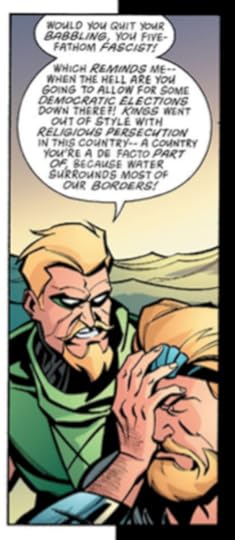 Aquaman’s face says it all. But ‘five-fathom fascist’ is a cracking insult, let’s be honest. Green Arrow #4 (2001)
Aquaman’s face says it all. But ‘five-fathom fascist’ is a cracking insult, let’s be honest. Green Arrow #4 (2001)While the Emerald Archer has been a fixture of many of the Justice League and other team-up books I’ve read over the years, I’ve only actually read one solo series of his, because it was the only one that was in the library when I was growing up. (The same library in which I first encountered the Justice League in a random 2004 TPB.) It was a collection from 2001, containing the Quiver and Sounds of Violence arcs. The former deals with Green Arrow’s resurrection – like almost every superhero, he died heroically and then came back to life, dealt with some amnesia along the way. It’s a fine arc. But it was Sounds of Violence that stuck with me, for one specific reason. It’s this page.
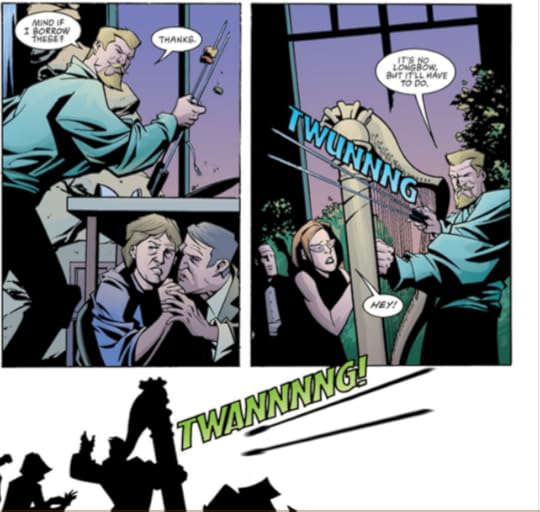 Green Arrow #12 (2002)
Green Arrow #12 (2002)Yes. That is Green Arrow, interrupted while out to dinner, shooting kebab skewers out of a harp. And…
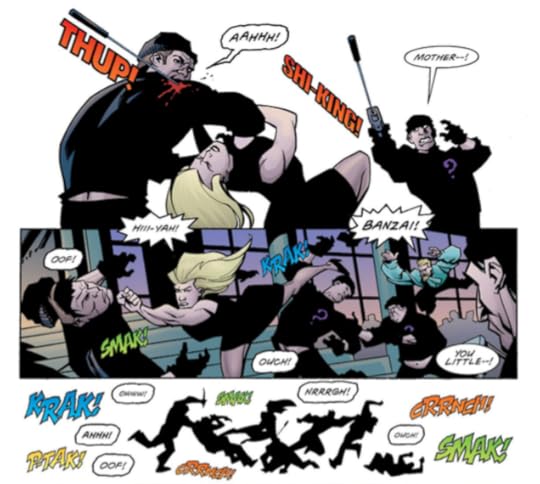 Green Arrow #12 (2002)
Green Arrow #12 (2002)…nailing it, because of course he does.
The fundamental problem with Green Arrow – and to a slightly lesser extent the more serious Hawkeye – is that they run around with lethal weapons and don’t like killing people. (In the comics, at least: the Arrow TV series went more murder-happy, and the MCU Hawkeye has no problem with killing, which works a lot better in my opinion.) Hawkeye has become more and more ‘serious’ over the years, as far as I can tell, despite the odd trick arrow. Green Arrow went through a similar journey; initially he killed nobody, then he killed someone by accident, then he was forced to kill someone… (Different interpretations, of course, vary.) In Quiver/Sounds of Violence he comes very close to killing on several occasions, and he’s generally forgoing the trick arrows in favour of simply crippling criminals by shooting them in the hands or legs. You know, not painful at all.
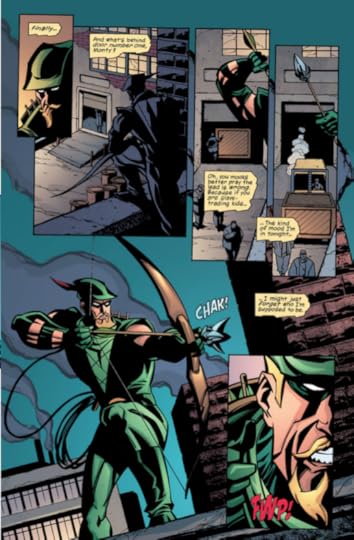 And sometimes he just openly admits that he’d like to murder you. Green Arrow #3 (2001)
And sometimes he just openly admits that he’d like to murder you. Green Arrow #3 (2001)Green Arrow gets angry. Batman does too, of course; he beats his villains to within an inch of their lives on occasion, held back by his iron will and his self-imposed no-kill rule. But Green Arrow doesn’t have that restraint. Green Arrow tries not to kill you, but he’ll really hurt you in the process. And if he gets too angry… well, he’s a man with a bow and arrow, and he’s a very good shot.
I think that’s why I like the Quiver/Sounds of Violence arc so much. Because it starts off with classic Green Arrow, boxing-glove arrows and political rants and plenty of pow/biff/wham action. Then it gets serious. Green Arrow is back, and he’s angry, and people are going to get hurt until his city gets better.
But even an angry Green Arrow is still an arrogant, mouthy show-off, and we can’t help but love him for it. And while he might have put down the boxing gloves, he still can’t resist a little unconventional weaponry from time to time. Or a good quip, even in the face of death.
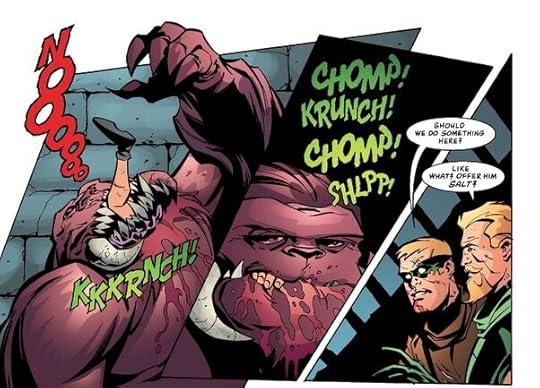 The guy killed a lot of children. It’s fair. Green Arrow #10 (2002)
The guy killed a lot of children. It’s fair. Green Arrow #10 (2002)It should go without saying, but all of the images above are the copyright of DC Comics.
July 24, 2022
D&D and Character Development
I did D&D a couple of days ago. It was brilliant. In rambling about it now, I want to touch on not just how fun it was, but a little on the wonderful organic storytelling that D&D engenders. But mostly on the fun.
Therefore, meet Sir Geoffrey du Babbage and his incompetent manservant Hansard.
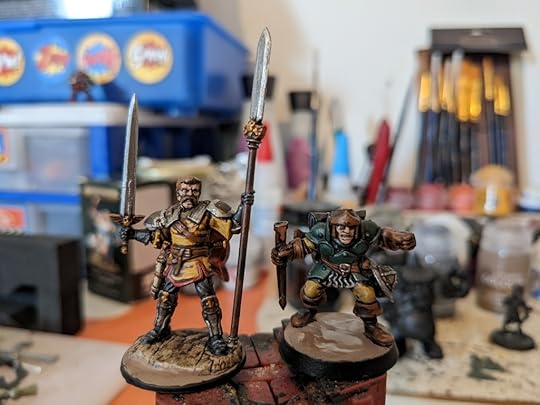
Think slightly more competent series 1 Blackadder, accompanied by significantly taller series 2 Baldrick. Add a hefty dash of Monty Python and you’re there. In D&D terms, a human fighter.
Sir Geoffrey will tell you that he’s the greatest hero of the age, a magnificent knight, adventurer and all round great guy. In reality, he’s flat broke, mostly an idiot, and went on a crusade through the wrong county due to a clerical error. The only thing that stops him looking like a complete imbecile is the fortuitous presence of his manservant Hansard, who is an idiot in search of a village, and serves as a replacement for Geoffrey’s horse. (Sweet Bucephalus; taken too soon.)
I haven’t been Sir Geoffrey du Babbage in a long time. He was first created long ago for my second Edinburgh Fringe run, in a sketch that was, while far too long and only semi-amusing to watch, was an absolute joy to perform. I got to ride onto the stage on my co-director’s back, brandishing a wooden sword and a false moustache, and do my best Python/Blackadder pastiche. It was awesome. So when I had to roll up a D&D character, there was only one choice, really.
 The original Sir Geoffrey (me) and Hansard (Luke Reilly) in 2016
The original Sir Geoffrey (me) and Hansard (Luke Reilly) in 2016It was a one-shot (Escape from the Crystal Fortress by Will Humberstone, the plot of which I will try to avoid spoiling here) with several members of my choir. Geoffrey, a teenage Halfling barbarian, a cat-bard and an elephant Druid went to prison, beat up some zombies and saved the day. The actual one-shot campaign was really good – the Crystal Fortress was amazingly atmospheric, the encounters were nail-biting (especially for a novice like me), but it was all concise enough to finish in an evening. (If you’re looking for a one-shot, Crystal Fortress is a great choice. Just remember to pick up some bricks along the way.)
The fact that it was a one -shot meant that this was the first time I’d actually finished an adventure. Both times I’ve played D&D before were the first sessions in what should have been bigger campaigns, which then of course fizzled out and were never picked up. In an alternate universe, Sir Geoffrey and Hansard have been standing completely naked in the middle of a town square for about 5 years. As this was a one-shot, however, we actually made it all the way through our little plot.
And it was fun. Because in most fantasy universes you’d never dream of throwing characters like ours together. You’d certainly not do so without a prodigious amount of backstory to set up their relationships, their motivations, the reason they’re all here in this magical prison. That’s certainly what I’d be doing if I was writing it as a conventional story.
But instead, we just turned up and rolled (heh) with it. And because we were a group of people instead of just me trying to think of everything, the story just bloomed into something wonderful. Mad and hilarious, but wonderful. We threw bricks at skeletons, we rescued cats. We bonded, or we started to at least. (We the players bonded magnificently; in character Sir Geoffrey is an arse so it’ll take a bit longer there.)
Thanks to our DM there was no need to think about the story itself – just what I would do. It was writing and acting and improv all at once. And it was a really, really good way to develop a character from a comedy sketch into something approaching a human being. I’m definitely playing with Geoffrey again. But I think I need to do it with some of my other characters too, if nothing else just to see what they’d do. I’ve always thought that good characters are the most important part of any story, setting and plot be damned – and it definitely feels like I might be right.
Maybe I should do what I originally planned, and turn the Boiling Seas into an RPG campaign. I’ve already got a map…

